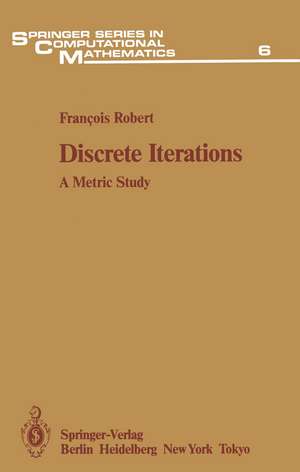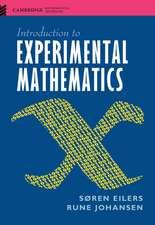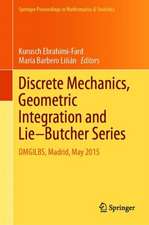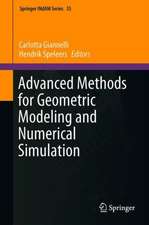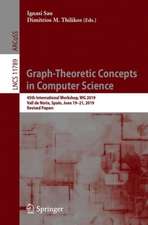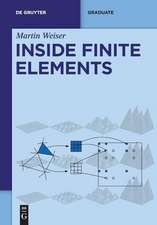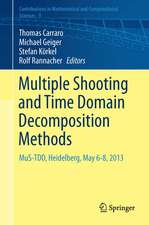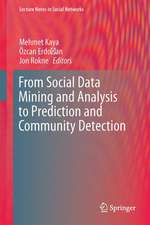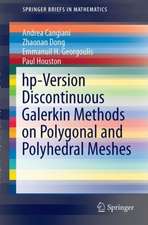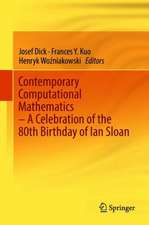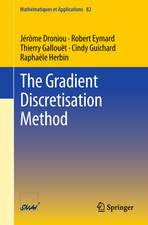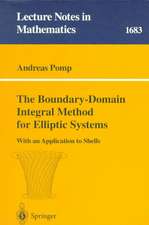Discrete Iterations: A Metric Study: Springer Series in Computational Mathematics, cartea 6
Autor Francois Robert Traducere de Jon Rokneen Limba Engleză Paperback – 6 oct 2011
Din seria Springer Series in Computational Mathematics
- 24%
 Preț: 703.01 lei
Preț: 703.01 lei - 15%
 Preț: 497.64 lei
Preț: 497.64 lei - 18%
 Preț: 726.85 lei
Preț: 726.85 lei -
 Preț: 403.91 lei
Preț: 403.91 lei -
 Preț: 386.61 lei
Preț: 386.61 lei - 18%
 Preț: 1399.11 lei
Preț: 1399.11 lei -
 Preț: 394.51 lei
Preț: 394.51 lei - 18%
 Preț: 1395.94 lei
Preț: 1395.94 lei - 18%
 Preț: 784.48 lei
Preț: 784.48 lei - 20%
 Preț: 996.22 lei
Preț: 996.22 lei - 24%
 Preț: 635.75 lei
Preț: 635.75 lei - 15%
 Preț: 649.22 lei
Preț: 649.22 lei -
 Preț: 400.47 lei
Preț: 400.47 lei - 18%
 Preț: 740.44 lei
Preț: 740.44 lei - 15%
 Preț: 643.65 lei
Preț: 643.65 lei -
 Preț: 380.63 lei
Preț: 380.63 lei - 18%
 Preț: 904.74 lei
Preț: 904.74 lei - 18%
 Preț: 1014.28 lei
Preț: 1014.28 lei - 18%
 Preț: 1111.97 lei
Preț: 1111.97 lei -
 Preț: 393.90 lei
Preț: 393.90 lei - 18%
 Preț: 947.98 lei
Preț: 947.98 lei - 15%
 Preț: 650.04 lei
Preț: 650.04 lei - 15%
 Preț: 658.05 lei
Preț: 658.05 lei - 15%
 Preț: 521.60 lei
Preț: 521.60 lei - 15%
 Preț: 660.04 lei
Preț: 660.04 lei - 18%
 Preț: 1397.52 lei
Preț: 1397.52 lei - 18%
 Preț: 1126.35 lei
Preț: 1126.35 lei - 18%
 Preț: 1117.48 lei
Preț: 1117.48 lei - 18%
 Preț: 793.76 lei
Preț: 793.76 lei - 15%
 Preț: 710.23 lei
Preț: 710.23 lei
Preț: 636.63 lei
Preț vechi: 748.97 lei
-15% Nou
Puncte Express: 955
Preț estimativ în valută:
121.83€ • 132.29$ • 102.34£
121.83€ • 132.29$ • 102.34£
Carte tipărită la comandă
Livrare economică 22 aprilie-06 mai
Preluare comenzi: 021 569.72.76
Specificații
ISBN-13: 9783642648823
ISBN-10: 3642648827
Pagini: 220
Ilustrații: XVI, 198 p.
Dimensiuni: 155 x 235 x 12 mm
Greutate: 0.31 kg
Ediția:Softcover reprint of the original 1st ed. 1986
Editura: Springer Berlin, Heidelberg
Colecția Springer
Seria Springer Series in Computational Mathematics
Locul publicării:Berlin, Heidelberg, Germany
ISBN-10: 3642648827
Pagini: 220
Ilustrații: XVI, 198 p.
Dimensiuni: 155 x 235 x 12 mm
Greutate: 0.31 kg
Ediția:Softcover reprint of the original 1st ed. 1986
Editura: Springer Berlin, Heidelberg
Colecția Springer
Seria Springer Series in Computational Mathematics
Locul publicării:Berlin, Heidelberg, Germany
Public țintă
ResearchCuprins
1. Discrete Iterations and Automata Networks: Basic Concepts.- 1. Discrete Iterations and Their Graphs.- 2. Examples.- 3. Connectivity Graphs and Incidence Matrices.- 4. Interpretations in Terms of Automata Networks.- 5. Serial Operation and the Gauss-Seidel Operator.- 6. Serial-Parallel Modes of Operation and the Associated Operators.- 2. A Metric Tool.- 1. The Boolean Vector Distance d.- 2. Some Basic Inequalities.- 3. First Applications.- 4. Serial-Parallel Operators. An Outline.- 5. Other Possible Metric Tools.- 3. The Boolean Perron-Frobenius and Stein-Rosenberg Theorems.- 1. Eigenelements of a Boolean Matrix.- 2. The Boolean Perron-Frobenius Theorem.- 3. The Boolean Stein-Rosenberg Theorems.- 4. Conclusion.- 4. Boolean Contraction and Applications.- 1. Boolean Contraction.- 2. A Fixed Point Theorem.- 3. Examples.- 4. Serial Mode: Gauss-Seidel Iteration for a Contracting Operator.- 5. Examples.- 6. Comparison of Operating Modes for a Contracting Operator.- 7. Examples.- 8. Rounding-Off: Successive Gauss- Seidelisations.- 9. Conclusions.- 5.Comparison of Operating Modes.- 1. Comparison of Serial and Parallel Operating Modes.- 2. Examples.- 3. Extension to the Comparison of Two Serial-Parallel Modes of Operation.- 4. Examples.- 5. Conclusions.- 6. The Discrete Derivative and Local Convergence.- 1. The Discrete Derivative.- 2. The Discrete Derivative and the Vector Distance.- 3. Application: Characterization of the Local Convergence in the Immediate Neighbourhood of a Fixed Point.- 4. Interpretation in Terms of Automata Networks.- 5. Application: Local Convergence in a Massive Neighbourhood of a Fixed Point.- 6. Gauss-Seidel.- 7. The Derivative of a Function Composition.- 8. The Study of Cycles: Attractive Cycles.- 9. Conclusions.- 7. A Discrete Newton Method.- 1. Context.- 2. Two Simple Examples.- 3. Interpretation in Terms of Automata.- 4. The Study of Convergence: The Case of the Simplified Newton Method.- 5. The Study of Convergence, The General Case.- 6. The Efficiency of an Iterative Method on a Finite Set.- 7. Numerical Experiments.- 8. Conclusions.- General Conclusion.- Appendix 2. The Number of Regular n x n Matrices with Elements in Z/p (p prime).- Appendix 4. Continuous Iterations-Discrete Iterations.- Inde.
